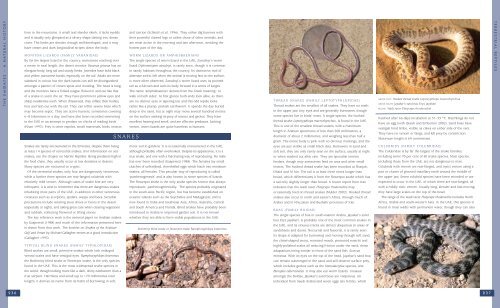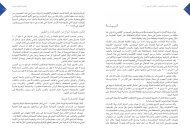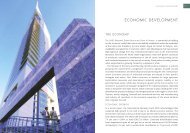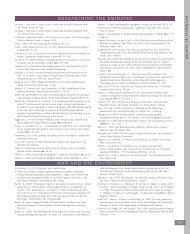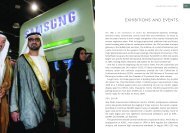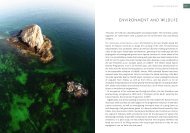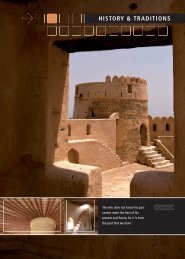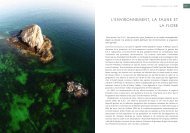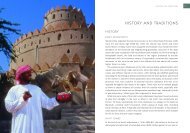TERRESTRIAL REPTILES - UAE Interact
TERRESTRIAL REPTILES - UAE Interact
TERRESTRIAL REPTILES - UAE Interact
Create successful ePaper yourself
Turn your PDF publications into a flip-book with our unique Google optimized e-Paper software.
T H E E M I R A T E S – A N A T U R A L H I S T O R Y<br />
lives in the mountains. A small and slender skink, it lacks eyelids and carrion (Schleich et al. 1996). They either dig burrows with<br />
and is usually only glimpsed as a silvery shape darting into dense their powerful clawed legs or utilise those of other animals, and<br />
cover. The limbs are slender, though well-developed, and it may are most active in the morning and late afternoon, avoiding the<br />
have cream and dark longitudinal stripes down the body.<br />
hottest part of the day.<br />
MONITOR LIZARDS (FAMILY VARANIDAE)<br />
WORM LIZARDS OR AMPHISBAENIANS<br />
By far the largest lizard in the country, sometimes reaching over The single species of worm lizard in the <strong>UAE</strong>, Zarudnyi’s worm<br />
a metre in total length, the desert monitor Varanus griseus has an lizard Diplometopon zarudnyi, is rarely seen, though it is common<br />
elongate body, long tail and sturdy limbs. Juveniles have bold black in sandy habitats throughout the country. Its distinctive trail of<br />
and yellow transverse bands, especially on the tail. Adults are more alternate swirls, left when the animal is moving fast on the surface,<br />
subdued in colour, but the dark bands can still be distinguished is more often observed. Zarudnyi’s worm lizard uses its pointed<br />
amongst a pattern of cream spots and mottling. The head is long, tail as a fulcrum and curls its body forward in a series of lunges.<br />
and the monitors have a forked tongue, flicked in and out like that The name ‘amphisbaenian’ derives from the Greek meaning ‘ to<br />
of a snake to scent the air. They have prominent yellow eyes and walk on both sides’. At first glance both ends look alike, as there<br />
sharp needle-like teeth. When threatened, they inflate their bodies, are no distinct eyes or tapering tail, and this odd reptile looks<br />
hiss and lash out with the tail. They can inflict severe bites which rather like a plump, pinkish earthworm. It spends the day buried<br />
may become septic. They are active hunters, sometimes covering deep in the sand, but at night may move several hundred metres<br />
6–8 kilometres in a day, and have also been recorded swimming on the surface seeking its prey of insects and geckos. They have<br />
in the <strong>UAE</strong> in an attempt to predate on chicks of wading birds excellent hearing and smell, and are effective predators. Lacking<br />
(Khan 1993). Prey is other reptiles, small mammals, birds, insects venom, worm lizards are quite harmless to humans.<br />
SNAKES<br />
Snakes are rarely encountered in the Emirates, despite there being moist soil in gardens. It is occasionally encountered in the <strong>UAE</strong>,<br />
at least 14 species of terrestrial snakes. (For information on sea although probably often overlooked. Despite its appearance, it is a<br />
snakes, see the chapter on Marine Reptiles). Being predators high in true snake, and one with a fascinating way of reproducing. No male<br />
the food chain, they usually occur at low densities in deserts. has ever been recorded (Gasperetti 1988). The females lay small<br />
Many species are nocturnal or cryptic.<br />
clutches of unfertilised, thin-shelled eggs which hatch into miniature<br />
Of the terrestrial snakes, only four are dangerously venomous, snakes, all females. This peculiar way of reproducing is called<br />
while a further three species are rear-fanged colubrids with<br />
‘parthenogenesis’ and is also known in some species of lizards.<br />
relatively mild venom. Although cases of snake bite are very The flowerpot snake is the only snake species known that always<br />
infrequent, it is wise to remember that there are dangerous snakes reproduces parthenogenetically. The species probably originated<br />
inhabiting most parts of the <strong>UAE</strong>, in addition to other venomous in the south-west Pacific region, but has become established on<br />
creatures such as scorpions, spiders, wasps and bees. Sensible oceanic islands such as the Seychelles and Madagascar, and is<br />
precautions include wearing stout shoes or boots in the desert now found in India and Southeast Asia, Africa, Australia, Central<br />
(especially at night), and taking great care when clearing vegetation and South America and Florida. Blind snakes have probably been<br />
and rubbish, collecting firewood or lifting stones.<br />
introduced to Arabia in imported garden soil. It is not known<br />
The key reference work is the seminal paper on Arabian snakes whether they are able to form viable populations in the <strong>UAE</strong>.<br />
by Gasperetti (1988) and much of the information presented here<br />
is drawn from that work. The booklet on Snakes of the Arabian<br />
Brahminy blind snake or flowerpot snake Ramphotyphlops braminus<br />
Gulf and Oman by Michael Gallagher serves as a good introduction<br />
(Gallagher 1993).<br />
TYPICAL BLIND SNAKES (FAMILY TYPHLOPIDAE)<br />
Blind snakes are small, primitive snakes which lack enlarged<br />
ventral scales and have vestigial eyes. Ramphotyphlops braminus,<br />
the Brahminy blind snake or flowerpot snake, is the only species<br />
found in the <strong>UAE</strong>. This is the most widespread snake species in<br />
the world, though looking more like a dark, shiny earthworm than a<br />
true serpent. Harmless and small (up to 170 millimetres total<br />
length), it derives its name from its habit of burrowing in soft,<br />
THREAD SNAKES (FAMILY LEPTOTYPHLOPIDAE)<br />
Thread snakes are the smallest of all snakes. They have no teeth<br />
in the upper jaw, tiny eyes and are generally burrowers, though<br />
some species live in birds’ nests. A single species, the hooked<br />
thread snake Leptotyphlops macrorhynchus, is found in the <strong>UAE</strong>.<br />
This is one of the smallest thread snakes, with a maximum<br />
length in Arabian specimens of less than 200 millimetres, a<br />
diameter of about 2 millimetres, and weighing less than half a<br />
gram. The entire body is pink with no obvious markings, and the<br />
eyes are just visible as small black dots. Burrowers in sand and<br />
soft soil, they are only rarely seen on the surface, usually at night<br />
or when washed out after rain. They are specialist termite<br />
feeders, though may sometimes feed on ants and other small<br />
insects. The hooked thread snake has been recorded at Sharjah,<br />
Dhaid and Al Ain. The tail is at least three times longer than<br />
broad, which differentiates it from the flowerpot snake which has<br />
a tail only slightly longer than broad. A recent report from Iran<br />
indicates that the wadi racer Platyceps rhodorachis may<br />
occasionally feed on thread snakes (Mulder 2002). Hooked thread<br />
snakes also occur in north and eastern Africa, through much of<br />
Arabia and in Khuzistan and Bushahr provinces of Iran.<br />
BOAS (FAMILY BOIDAE)<br />
The single species of boa in south-eastern Arabia, Jayakar’s sand<br />
boa Eryx jayakari, is probably one of the most common snakes in<br />
the <strong>UAE</strong>, and its sinuous tracks are almost ubiquitous in areas of<br />
sandsheets and dunes. Nocturnal and fossorial, it is rarely seen.<br />
Its shape is adapted for burrowing and moving through soft sand,<br />
the chisel-shaped snout, recessed mouth, protected nostrils and<br />
highly-polished scales all reducing friction under the sand, these<br />
adaptations being similar to those of the sand fish, Scincus<br />
mitranus. With its eyes on the top of the head, Jayakar’s sand boa<br />
can remain submerged in the sand and still observe surface prey,<br />
which includes geckos such as the Stenodactylus species, and<br />
Bunopus tuberculatus. It may also eat worm lizards. Unusual<br />
amongst the Boidae, Jayakar’s sand boas are viviparous. An<br />
individual from Saudi Arabia laid seven eggs (six fertile), which<br />
ABOVE LEFT: Hooked thread snake Leptotyphlops macrorhynchus<br />
ABOVE RIGHT: Jayakar’s sand boa Eryx jayakari<br />
BELOW: Wadi racer Platyceps rhodorachis<br />
hatched after 66 days incubation at 31–33 ºC. Hatchlings do not<br />
have an egg tooth (Staub and Emberton 2002). Sand boas have<br />
vestigial hind limbs, visible as claws on either side of the vent.<br />
They have no venom or fangs, and kill prey by constriction.<br />
Maximum length is 64 centimetres.<br />
COLUBRIDS (FAMILY COLUBRIDAE)<br />
The Colubridae is by far the largest of the snake families,<br />
including some 70 per cent of all snake species. Most species,<br />
including those from the <strong>UAE</strong>, are not dangerous to man.<br />
Colubrids with venom are rear-fanged, and inject venom using a<br />
pair or cluster of grooved maxillary teeth around the middle of<br />
the upper jaw. Seven colubrid species have been recorded or are<br />
expected to occur in the <strong>UAE</strong>, of which three are rear-fanged, all<br />
with a mildly toxic venom. Usually long, slender and fast-moving,<br />
they have large scales on the top of the head.<br />
The range of the wadi racer Platyceps rhodorachis includes North<br />
Africa, Arabia and south-western Asia. In the <strong>UAE</strong>, this species is<br />
found in most wadis with permanent water, though they can also<br />
T E R R E S T R I A L R E P T I L E S<br />
236<br />
237


